With a lot to try and fit in
on our trip down to the Florida Keys, we awoke bright and early, the sky still
a stormy inky black and the faint call of migrating Palm Warblers overhead
reminding us that despite being in the big city, nature never stops. Negotiating
speed cameras and bizarre minimum speeds on the roads to Miami, we were soon at
our first stop of the day – a bridge on the SW 216th Street &
Ronald Raegan Turnpike overlooking the canal that is famous for its nesting
Cave Swallows. Usually found across Central America and Texas, this is a
difficult species to catch up with in Florida without a special visit to a
known nesting colony, of which there are just a handful around the outskirts of
Miami.
 |
| Cave Swallow - ridiculously hard to photograph! |
Barely having time to admire the fluffy chicks accompanying the two adult Muscovy Ducks that came waddling up to us as we left the car, we were soon gazing upon a mass of Cave Swallows swooping under the bridge and congregating over our heads, performing in the
air with incredible acrobatic skill. Speeding past us and constantly weaving
through the sky, it was exceptionally difficult to photograph these agile
hirundines, eventually getting the shot I was after on my last attempt out of
about 200!
Similar to the Cliff Swallow (considerably
rarer in Florida), Cave Swallows can be distinguished by their much paler
throats in comparison to the darker red of the Cliff Swallow, as well the
lighter coloured foreheads and lack of white patch above the bill as on Cliff.
Standing on the bridge and
admiring these attractive swallows for around half an hour, we both marvelled
every time one sped past our face before swooping down low to make a pass under
the bridge beneath us. Fantastic!
Having had our fill of the
Cave Swallows and with a jam packed day travelling down to the Keys ahead, we
pressed on to our next site – Black Point Park Marina and the home of the
elusive Mangrove Cuckoo. Mysterious and almost mythical with its hard to track
down reputation preceding it, Mangrove Cuckoos are without doubt the hardest of
the three species of American Cuckoos to observe, and this was a bird I was especially
hoping we would be able to connect with. Sporting an attractive “bandit” style
eye-mask complete with a smart curved bill and beady eyes, Mangrove Cuckoos are
notoriously hard to find, often the only giveaway to their presence being an
extraordinary loud call more reminiscent of a monkey!
 |
| The elusive Mangrove Cuckoo |
Usually moving up to Florida
towards the middle of April onwards, we had originally thought we were far too
early to even stand a chance, but the discovery on e-bird of an individual
overwintering at Black Point Park Marina gave us fresh hope. Still present
during our trip and being reported from the same patch of Mangroves every time,
this was our best and realistically only chance of catching up with this
enigmatic species.
 |
| Mangrove Skipper - an impressive resident of the mangroves at Black Point Park Marina |
Arriving at the car park and
strolling around the outside of the Mangroves originally drew a blank – plenty
of butterflies flitting around the gnarled and twisted trunks provided us with
a distraction, while our only Racoon of the trip ungainly clung to the branches
in an attempt to get down from his ill-thought out perch at the top of a
Mangrove.
 |
| The mangroves! |
A further search of the area
also revealed our first Yellow-crowned Night Heron in the form of a streaked
juvenile slowly crossing the road in pursuit of prey on the opposite side.
 |
| Yellow-crowned Night Heron |
Allowing us a close approach, we were really able to see the thick strong bill,
and glad to finally catch up with this species after missing one at Jamaica Bay
in New York the previous year, we stopped to watch as it stared intently into
the Mangrove mud.
Turning our attention back to
the task at hand, we returned to the car park where the Mangrove Cuckoo records
emanated from, and before long were astounded to hear the distinctive call
echoing from the trees right in front of us – now was our chance. Straining to
catch a glimpse of sooty grey plumage from in-between the glossy Mangrove
leaves, Alex soon called out that he had it, and a frantic few minutes of
directions and trying to get me on it followed. Panicking I was about to miss
our prize, I eventually locked on to this most attractive cuckoo – elegantly
perched on one of the thin twigs and peering out intently.
 |
| Mangrove Cuckoo |
Moving further up
the tree to the exposed branches at the top, we were treated to unparalleled
views of this Mangrove specialist in full view and completely unobscured,
providing us with some excellent photographic opportunities – what a bird!
Practically dancing with
happiness at our success, we watched on as the cuckoo retreated back in to the
Mangroves, losing sight of it as it blended back in to the thicket of leaves
and back to a life in hiding.
Ecstatic that this Florida
speciality was safely under our belts, we headed south to begin the journey to
the Keys, stopping off at Florida City on route to track down the gang of
Common Mynas that make the area their home. Native to the Caspian Sea region,
Kazakhstan and through to the Indian Subcontinent, and having flourished in the
area since being introduced back in the 1980’s, Common Mynas are, like Muscovy
Ducks and Spot-breasted Orioles, fully countable on ABA checklists. Managing to
eventually locate a handful of Mynas in the Starbucks and adjacent petrol
station car parks, we quickly found that they had a particular penchant for
Pringles, and were soon enjoying point blank views as they fed around the car.
 |
| Common Myna |
With a 9th for the
US in the form of a Zenaida Dove currently in residence at Long Key State Park
halfway down the Keys, it would have been stupid not to call in and give it a
shot. Usually more at home in the Caribbean and Central America, this was a
mega in terms of American birding, and it had attracted a large number of
birders to the area during its 3 month stay. Driving through Key Largo and the
other small towns lining the Florida panhandle, the landscape noticeably
changed, with shallow lagoons and Mangroves now lining the road complete with
picturesque white sandy beaches and beautiful blue ocean vistas. Our first
Magnificent Frigatebird of many soared majestically overhead, these pirates of
the sea present in good numbers around the Florida coastline and one of the
only places in America to see this prehistoric looking bird.
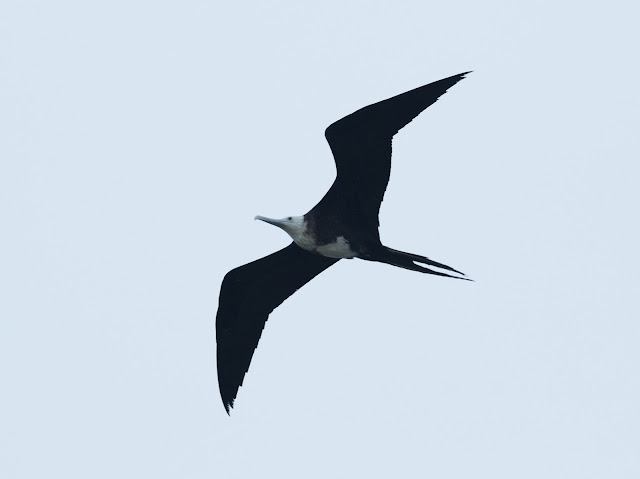 |
| Magnificent Frigatebird |
Arriving at Long Key, the
sweltering midday heat ensured that we weren’t able to stay out in the open for
long, exceptionally glad of the shade the mangroves offered. With two other
birders having been searching since the early hours of the morning but with no
luck, we set to work trying to track down what at times could be an exceptionally
elusive dove.
 |
| Long Key viewpoint tower! |
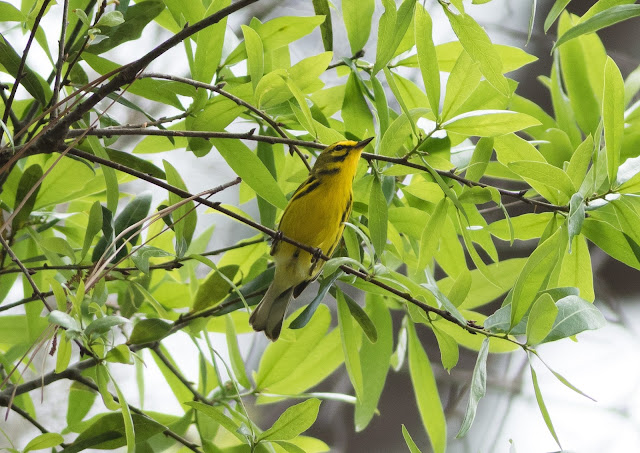 |
| Prairie Warbler |
With a male Prairie Warbler
flitting through the leaves as company and an exceptionally showy Willet on the
tideline, I remembered several e-bird notes saying observers had located the
Zenaida Dove by hearing rustling in the undergrowth. With several Mourning
Doves feeding on the track and providing false alarms, on what was only our
first proper search of the Golden Orb Trail I heard a slight movement under the
nearby bushes and caught a glimpse of a tan coloured dove shyly moving through
the leaves. Raising my bins, a striking flash of white on the wings
unbelievably confirmed my suspicions – Zenaida! As easy as that!
 |
| Zenaida Dove! |
Dodging around the bush, we
sadly couldn’t get any better views as the dove was obscured by the tangle of
branches and leaves, but the white spot on the wings was all we needed,
diagnostic in the identification of this mega bird and in separating it from
the exceptionally similar Mourning Doves.
 |
| The diagnostic white spot on the wing |
Pleased with our success and
the heat now getting too much, we headed on to our final location of Key West, stopping
off on route to check the shore line for any interesting waders. Sadly, the
small peeps running around the Mangrove bays were just a tad too distant to
confirm for definite if there were any yellow-legged Least Sandpipers knocking
about amongst them, and getting increasingly tired after a series of long days
in the field we pressed on to our hotel for the night in the heart of Key West.
With the long day getting a bit too much and with the traffic jams heading in to Key West rendering us at a standstill, I was soon abruptly awoken from my nap by Alex shouting and pointing excitedly out of the window – “White-crowned Pigeons!” Sure enough, looking across the road bleary eyed, I soon caught sight of 4 of these beautiful and sleek pigeons perched on the telephone wires, their sooty grey bodies topped with an attractive snow white cap.
 |
| White-crowned Pigeons |
Migrants in to Key West and with no definite site for these impressive birds, it was sheer luck that we’d managed to jam in on them by the side of the road, and before our trip had begun we had been apprehensive as to whether we would catch up with any. Pulling over in to the entrance of the nearby golf resort where they were perched (we did cause a little bit of chaos and the beeping of horns by disgruntled golfers), we were able to get much closer views of this Florida Keys speciality and reel off a few photographs.

Extremely pleased to get the White-crowned Pigeons under our belt, we re-joined the traffic, eventually reaching our hotel in the centre of Key West nestled within the palm trees and boasting a lush garden, sitting out on the balcony revealed our first Indigo Bunting of the trip, feeding on the seed on an adjacent rooftop and soon joined by a rather skittish Common Ground Dove. Several Roosters also wandered freely below, a regular sight in the town and one of the many we encountered during our stay.
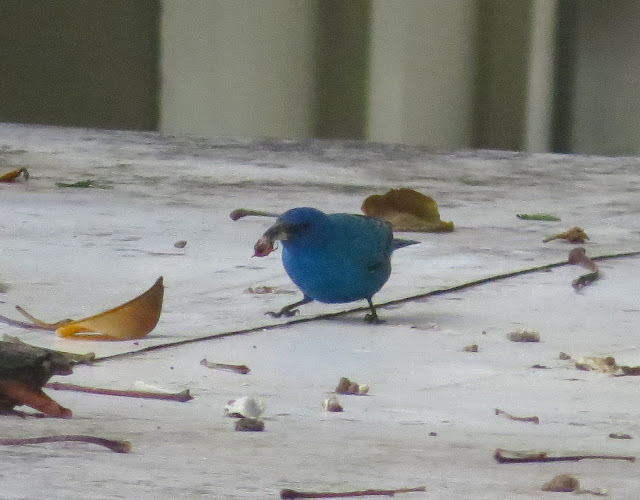 |
| Indigo Bunting |
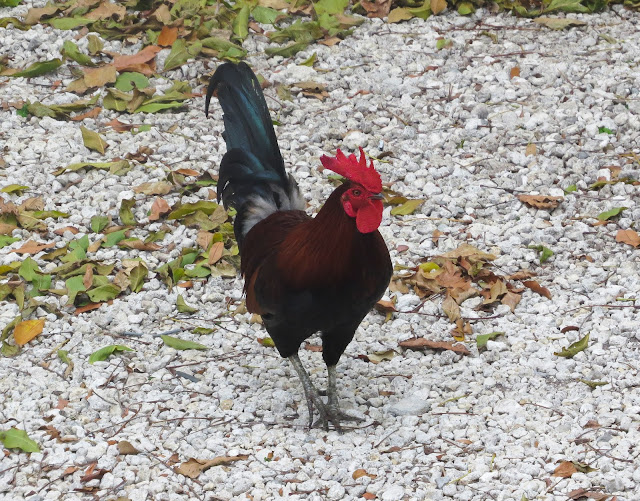 |
| Rooster! |
Refreshing ourselves with a
truly delicious meal of orange chicken for me and Yellowtail Snapper for Alex
in one of the top local restaurants, we were ready for tomorrow and one of the
days we had both been looking forward to the most – our day trip out by boat to
the paradise that are the Dry Tortugas islands.



















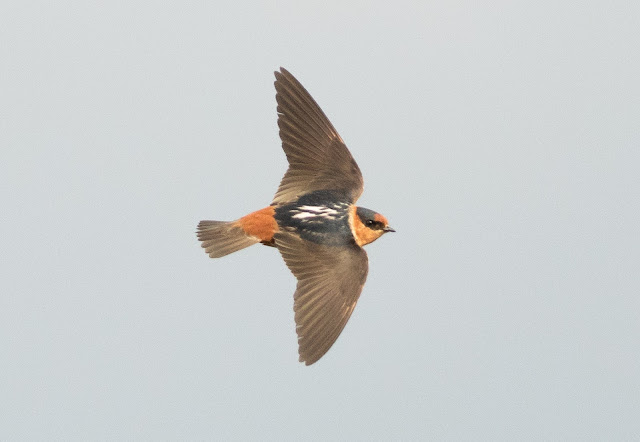











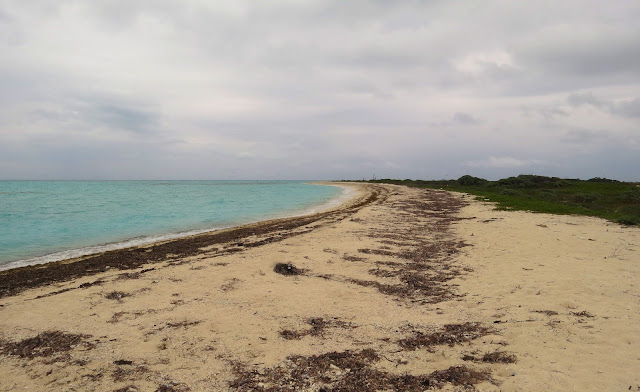
No comments:
Post a Comment